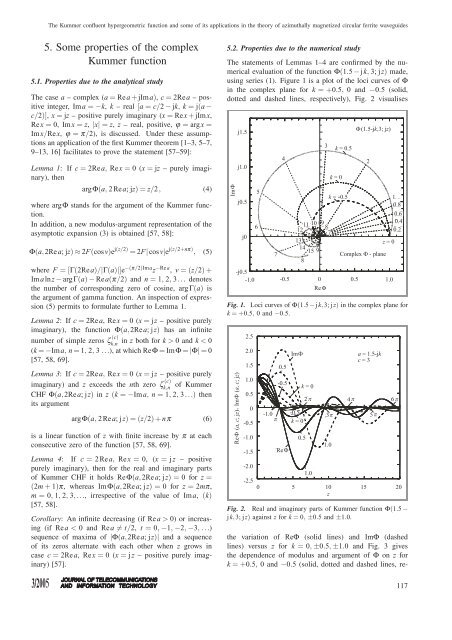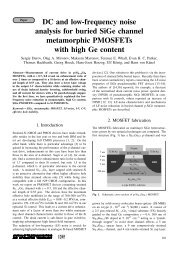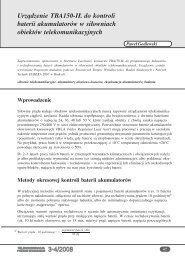The Kummer confluent hypergeometric function and some of its ...
The Kummer confluent hypergeometric function and some of its ...
The Kummer confluent hypergeometric function and some of its ...
Create successful ePaper yourself
Turn your PDF publications into a flip-book with our unique Google optimized e-Paper software.
<strong>The</strong> <strong>Kummer</strong> <strong>confluent</strong> <strong>hypergeometric</strong> <strong>function</strong> <strong>and</strong> <strong>some</strong> <strong>of</strong> <strong>its</strong> applications in the theory <strong>of</strong> azimuthally magnetized circular ferrite waveguides<br />
5. Some properties <strong>of</strong> the complex<br />
<strong>Kummer</strong> <strong>function</strong><br />
5.1. Properties due to the analytical study<br />
<strong>The</strong> case a – complex (a = Rea+jIma), c = 2Rea – positive<br />
integer, Ima = −k, k – real [a = c/2 − jk, k = j(a −<br />
c/2)], x = jz – positive purely imaginary (x = Rex+jImx,<br />
Rex = 0, Imx = z, |x| = z, z – real, positive, ϕ = argx =<br />
Imx/Rex, ϕ = π/2), is discussed. Under these assumptions<br />
an application <strong>of</strong> the first <strong>Kummer</strong> theorem [1–3, 5–7,<br />
9–13, 16] facilitates to prove the statement [57–59]:<br />
Lemma 1: If c = 2Rea, Rex = 0 (x = jz – purely imaginary),<br />
then<br />
argΦ(a, 2Rea; jz) = z/2, (4)<br />
where argΦ st<strong>and</strong>s for the argument <strong>of</strong> the <strong>Kummer</strong> <strong>function</strong>.<br />
In addition, a new modulus-argument representation <strong>of</strong> the<br />
asymptotic expansion (3) is obtained [57, 58]:<br />
Φ(a,2Rea; jz) ≈ 2F(cosv)e j(z/2) = 2F|cosv|e j(z/2+nπ) , (5)<br />
where F = [Γ(2Rea)/|Γ(a)|]e −(π/2)Ima z −Rea , v = (z/2)+<br />
Imalnz − argΓ(a) − Rea(π/2) <strong>and</strong> n = 1, 2, 3... denotes<br />
the number <strong>of</strong> corresponding zero <strong>of</strong> cosine, argΓ(a) is<br />
the argument <strong>of</strong> gamma <strong>function</strong>. An inspection <strong>of</strong> expression<br />
(5) perm<strong>its</strong> to formulate further to Lemma 1.<br />
Lemma 2: If c = 2Rea, Rex = 0 (x = jz – positive purely<br />
imaginary), the <strong>function</strong> Φ(a,2Rea; jz) has an infinite<br />
number <strong>of</strong> simple zeros ζ (c)<br />
k,n<br />
in z both for k > 0 <strong>and</strong> k < 0<br />
(k = −Ima, n = 1, 2, 3 ...), at which ReΦ = ImΦ = |Φ|=0<br />
[57, 58, 69].<br />
Lemma 3: If c = 2Rea, Rex = 0 (x = jz – positive purely<br />
imaginary) <strong>and</strong> z exceeds the nth zero ζ (c)<br />
k,n <strong>of</strong> <strong>Kummer</strong><br />
CHF Φ(a,2Rea; jz) in z (k = −Ima, n = 1, 2, 3...) then<br />
<strong>its</strong> argument<br />
argΦ(a, 2Rea; jz) = (z/2)+nπ (6)<br />
is a linear <strong>function</strong> <strong>of</strong> z with finite increase by π at each<br />
consecutive zero <strong>of</strong> the <strong>function</strong> [57, 58, 69].<br />
Lemma 4: If c = 2Rea, Rex = 0, (x = jz – positive<br />
purely imaginary), then for the real <strong>and</strong> imaginary parts<br />
<strong>of</strong> <strong>Kummer</strong> CHF it holds ReΦ(a,2Rea; jz) = 0 for z =<br />
(2m + 1)π, whereas ImΦ(a,2Rea; jz) = 0 for z = 2mπ,<br />
m = 0, 1, 2, 3,..., irrespective <strong>of</strong> the value <strong>of</strong> Ima, (k)<br />
[57, 58].<br />
Corollary: An infinite decreasing (if Rea > 0) or increasing<br />
(if Rea < 0 <strong>and</strong> Rea = t/2, t = 0, −1, −2, −3, ...)<br />
sequence <strong>of</strong> maxima <strong>of</strong> |Φ(a,2Rea; jz)| <strong>and</strong> a sequence<br />
<strong>of</strong> <strong>its</strong> zeros alternate with each other when z grows in<br />
case c = 2Rea, Rex = 0 (x = jz – positive purely imaginary)<br />
[57].<br />
5.2. Properties due to the numerical study<br />
<strong>The</strong> statements <strong>of</strong> Lemmas 1–4 are confirmed by the numerical<br />
evaluation <strong>of</strong> the <strong>function</strong> Φ(1.5 − jk, 3; jz) made,<br />
using series (1). Figure 1 is a plot <strong>of</strong> the loci curves <strong>of</strong> Φ<br />
in the complex plane for k = +0.5, 0 <strong>and</strong> −0.5 (solid,<br />
dotted <strong>and</strong> dashed lines, respectively), Fig. 2 visualises<br />
Fig. 1. Loci curves <strong>of</strong> Φ(1.5−jk,3; jz) in the complex plane for<br />
k = +0.5, 0 <strong>and</strong> −0.5.<br />
Fig. 2. Real <strong>and</strong> imaginary parts <strong>of</strong> <strong>Kummer</strong> <strong>function</strong> Φ(1.5 −<br />
jk,3; jz) against z for k = 0, ±0.5 <strong>and</strong> ±1.0.<br />
the variation <strong>of</strong> ReΦ (solid lines) <strong>and</strong> ImΦ (dashed<br />
lines) versus z for k = 0, ±0.5, ±1.0 <strong>and</strong> Fig. 3 gives<br />
the dependence <strong>of</strong> modulus <strong>and</strong> argument <strong>of</strong> Φ on z for<br />
k = +0.5, 0 <strong>and</strong> −0.5 (solid, dotted <strong>and</strong> dashed lines, re-<br />
117





